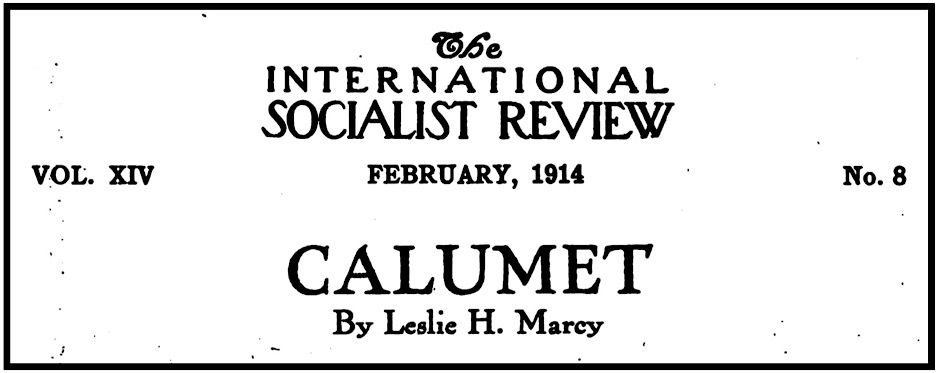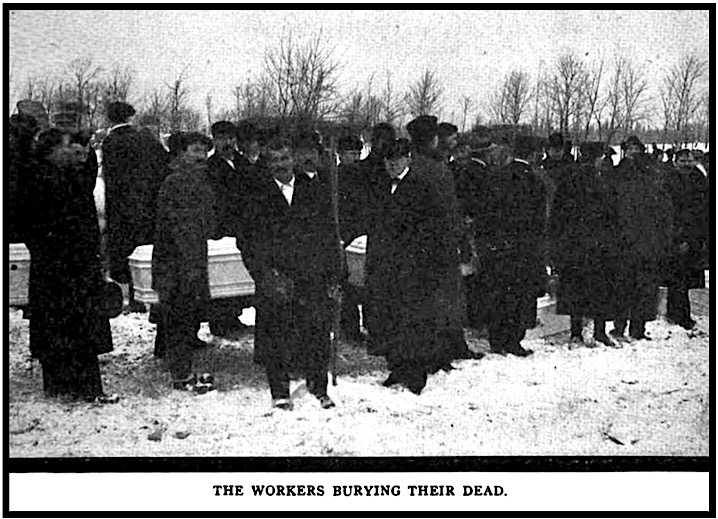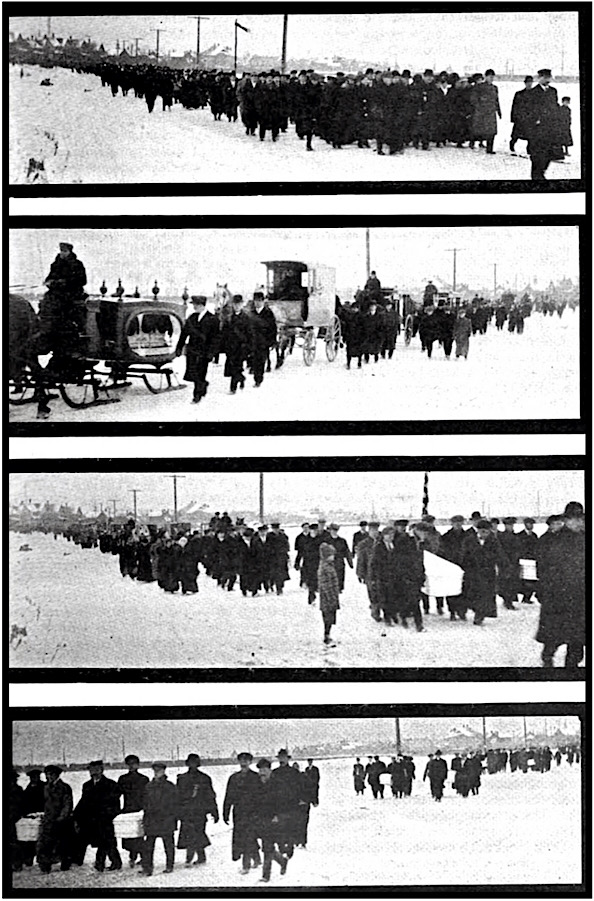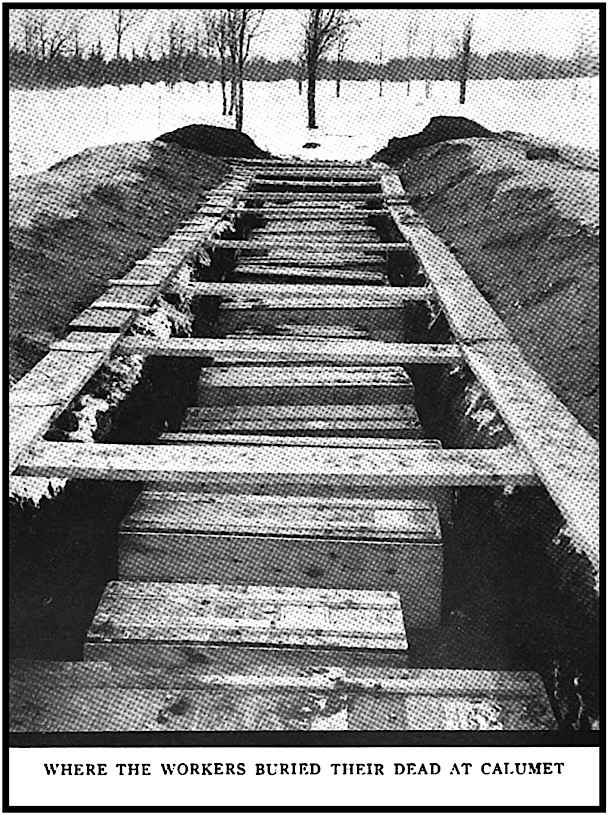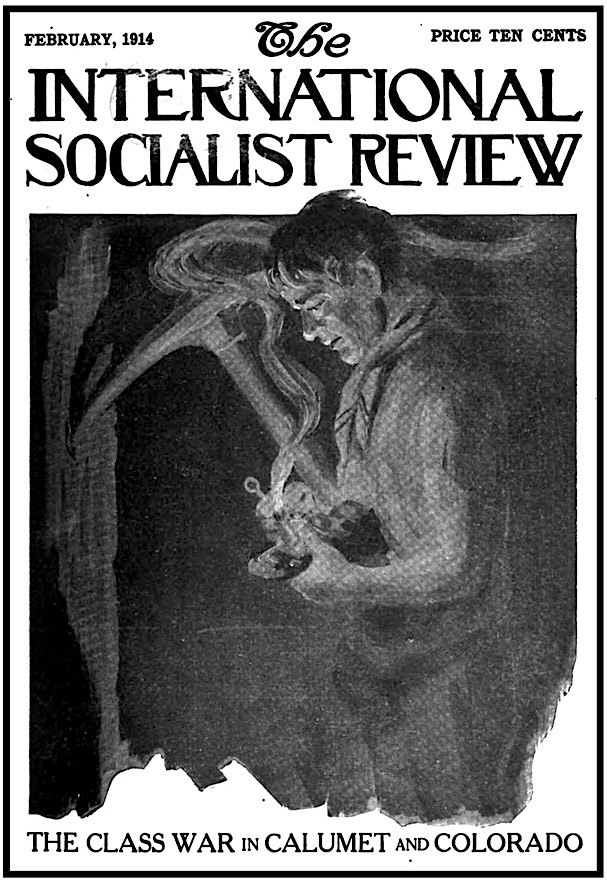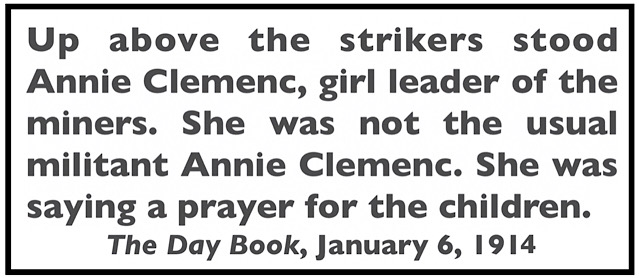 —————
—————
Hellraisers Journal – Tuesday February 3, 1914
“Calumet” by Leslie H. Marcy, Part II-Profits, Wages and Working Conditions
From the International Socialist Review of February 1914:
[Part II of II]
We have seen how the copper country is governed by an “invisible government”; from the judge on the bench, to the grand jury in session; from the national guard of the state of Michigan, on “duty,” since July 24, 1913, to the sheriff with his hundreds of imported professional strike breakers whom he swore in as deputies. The Calumet and Hecla Mining Company, Calumet, is the invisible government of Michigan.
This poor-little-rich corporation was “created” in the early fifties. According to a statement given out by Attorney Peterman, and endorsed by General Manager W. F. Denton, and General Manager C. L. Lawton, we find this devout confession: ”The profits of the Calumet and Hecla have been large, but they were due solely to the fact that the Creator put such rich ore in the company’s ground.”
However, Congress in the year of our Lord, 1852, seems to have been in total ignorance of this little gift on the Creator’s part to the copper crowd, for we find that “it gave to the state of Michigan 750,000 acres of public land, to aid it in building a ship canal around the Falls of St. Mary. The state in turn bargained this land to the contractors who built the canal, at a dollar and a quarter an acre. The lands thus disposed of at so beggarly a price were supposed to be swamp, or overflowed lands, but somehow, and strange to say, a part of them are now the rocky matrices from which the Calumet and Hecla has long been extracting shot-copper,-that company having in some way got hold of them. Years later a man named Chandler, who claimed to have bought the same land over again from the State of Michigan, brought a suit to dispossess the copper company,-charging all sorts of fraud in the switching of swamps so as to be quarries of copper-bearing rock. But the Supreme Court ruled against him, on the ground that as he got his deed from the state, he was in no better plight than the state, and that the state could not go back on its first deed to the canal contractors: so the Calumet and Hecla people kept it.”
This “good thing” was capitalized for $2,500,000 in shares of $25 each, instead of $100-note that. Of this $25 a share, only $12 was paid in. A total cash investment of $1,200,000. According to the Mining and Engineering World of December 27th, Calumet and Hecla has declared dividends on issued capitalization to December 1, 1913, amounting to $121,650,000, or $1,216 a share or $101 profits for each dollar invested.
Dividends for 1900 amounted to 320 per cent; for 1906, 280 per cent; for 1907, 260 per cent. In the Boston market, the stock was quoted on the day before New Years, at 427, bid price. Bearing in mind that the par value of the shares is but $25, this figure means that the stock is now worth more than 1,700 per cent, and bearing in mind also that only $12 a share was actually paid in, it means more than 3,400 per cent, market value. The president of the company receives a salary greater than the president of the United States.
Not long ago, when dividends threatened to be unusually enormous, the company purchased an extensive island in Lake Superior, stocked it with the finest game, and it is now used by stockholders of the company as a hunting preserve.
And the capitalists, who have never seen the inside of a mine shaft, who have stolen and defrauded to gain possession of the Calumet mines, have refused to permit their wage slaves, who produce all the wealth brought out of the mines, to organize into a union. They have denied the right of these workers to organize to demand more wages and better working conditions. Their arrogance is summed up in the words “We have nothing to arbitrate.”
These capitalists want MORE labor from the laborers. They are not satisfied with having stolen hundreds of millions from the men who have dug the wealth from the dangerous recesses of the earth. They demand still MORE.
* * * * * * *
Every day, in the dark of the early morning, John Kolu trudges through the deep snow a mile or more to the shaft house. From the time he is shot down the cage into the bowels of the earth until he reaches the stope where he works, an hour and a half is consumed. Bad luck for him, if the cable breaks or there is trouble in the engine room, for there are no protectors to the men’s cages. Down he goes, from 2,000 to 8,000 feet toward the center of the earth in subterranean caves, drills, blasts and gathers the precious copper that has helped to make modern industry and civilization possible. Lack of protectors is a violation of all mining laws.
Eleven hour shifts all these years! Air so hot that only the strongest lungs can stand the torture! And each miner must sign an agreement whether he understands English or not. The driller agrees to work for so much a foot, but owing to the rock he never knows what his wages will amount to. Examination of about 2,000 due bills, or pay envelopes, showed that some drillers had made 43 cents per day in a full month’s work. The highest was $2.65 per day, while some showed a deficit!
The latest little dividend maker for exploiting the copper miner is called, the one man drill. One driller has to do the work of two, hence these new machines were enthusiastically installed by the Calumet and Hecla and are one of the chief causes of the strike. It drove a lot of men out of the mines on account of being so hard and heavy to handle; it threw old miners, over 45, on the scrap pile. Only the strongest young men can pack it up a dark stope, put up his platform 100 feet and operate this 150-pound machine.
The trammers work in pairs loading the rock and pushing the ton capacity cars to the shaft where it is hoisted to the rock house. They also have been forced to sign a slave agreement to tram so many cars per day. The wages are less and hours of inhuman toil longer than are the drillers. A slight scratch from the poisonous copper rock and they are disabled, more often they are mangled by falling rock. The benevolent copper companies take a dollar out of all pay envelopes monthly-for the company doctor!
And when the dangerous work is performed and the copper is brought to the surface of the earth, the miner is separated from the wealth he has dug and it is appropriated by Boston capitalists who have never seen a mine or lifted a hand in honest labor.
And when the Calumet miners went out on strike, the capitalists wiggled their fingers and a thousand hungry lackeys sprung up to carry out their wishes.
Employment agencies were subsidized with such success that when men, who had been fooled and deceived into signing on for work in the copper mines, passed through Chicago, they were kept behind steel bars at the DEPOTS to prevent the truth being told them by members of the union. The Commissioner of Labor was refused admittance to them. They were whirled away to the copper district with the shackles of peonage already wrought upon their ankles.
Every possible item is charged against the misguided scabs: railway fare, huge employment agent fees, clothing, tools, food, lodging, etc., etc. The scabs are herded in huge bunk houses which are isolated and kept under a heavy armed guard. Upon these bunk houses the company searchlights are forever playing and any man who seeks entrance or ingress (except the changing mine shifts), is immediately shot.
Consequently the mine owners have virtual slaves or peons over whom they are using the power of life and death-to do their work in the mines.
Richard Maher, hired with a party of forty by the Ascher Detective Agency, New York, makes affidavit to the effect that when men came to the mines to work and saw what was going on, they were prevented from going away and held against their will. Maher was one of the men hired to guard them. The guards placed by the detective agencies were armed with rifles, revolvers and night sticks. They were sent out to break up parades of the miners. “We had suggestions made to us that the job was getting too quiet and that we should go out and start something. Our standing order was to shoot the first man that came near our sight on the highway which ran near the company’s property. We were informed that we could go as far as we liked and that the sheriff would not interfere with us,” said Maher, upon oath.
But we might mention here that the physical prowess of the striking miners has put a very wholesome fear into the hearts of the thugs and drunken militia men, and that they have learned that discretion may prove the better part of valor. They have ceased perpetrating former outrages upon the miners’ wives and children.
Nearly all of the strikers have served in European armies. Their drills resemble nothing so much as perfectly trained regiments of soldiers. And they fall in line for parade in less than five minutes. Only 5 per cent of the strikers are native born Americans. Twenty-three different nationalities are represented in the mines and the companies have always used every effort to keep the men as divided on religious and national grounds, as possible.
About four years ago the Finnish Socialists organized the first union in the copper country, that amounted to anything, at Hancock, Mich., and affiliated with the Western Federation of Miners.
At a meeting of the Hancock Copper Miners’ Union last June the rank and file formulated the following demands:
An eight-hour day; a minimum wage of $3.00 a day for men in the mines. An increase of 35 cents a day for those that worked above the ground. Two men to be employed on each drill. Recognition of the Western Federation of Miners.
The management of the mines ignored the presentation and 98 per cent of the men voted to go on strike which was called on July 23, 1913.
Regarding strike conditions Graham R. Taylor writes in The Survey as follows:
“While there had been some violence from the time the miners went out on July 23, the most serious instance during the first few weeks, and the occasion of the first fatalities, came when two deputy sheriffs and four detective “gun men” wantonly killed three strikers as they were eating their evening meal in their boarding house. This murder had, as pointed out by the article in The Survey, much to do with the temper of the struggle and the attitude of the strikers toward mine guards and deputy sheriffs, and in its light much of the subsequent violence is to be regarded.”
In the report of the Department of Labor investigator, Walter B. Palmer, we find:
Many Michigan militiamen became intoxicated and were allowed to wander about the streets armed.
Much violence, some of which resulted in fatalities, was provoked by the armed deputies imported by the mining companies.
Many of the mines are entirely lacking in proper provisions for safety, sanitation, and supply of drinking water for the employes.
Employes who have built houses on land rented from the Calumet and Hecla company may be dispossessed of their property when they are discharged or otherwise leave the employment of the concern.
Men employed in the mines as trammers perform the labor of beasts of burden and soon wear out.
The call for money to build up a Children’s Strike Benefit Fund, recently sent out by the Woman’s Department; National office, of the Socialist Party, has met with a generous response from all over the country. Comrade Winnie Branstetter is to be congratulated on her splendid idea. Three thousand dollars has come in and she is rushing relief in the way of clothes and shoes, as reports from the strike zones indicate that the children are suffering
Before these strikers are beaten back to work, let every union copper miner with a backbone throw away his tools and and refuse to work.
[Emphasis added.]
~~~~~~~~~~~~~~~~~~~~~~~~~
SOURCES & IMAGES
Quote re Annie Clemenc at Mass Funeral Calumet, Day Book p4, Jan 6, 1914
https://chroniclingamerica.loc.gov/lccn/sn83045487/1914-01-06/ed-1/seq-4/
International Socialist Review
(Chicago, Illinois)
-Feb 1914, pages 252-462
Cover Artwork by Arthur Machia
https://www.marxists.org/history/usa/pubs/isr/v14n08-feb-1914-ISR-gog-ocr.pdf
See also:
Hellraisers Journal – Monday February 2, 1914
“Calumet” by Leslie H. Marcy, Part I-The Fighting Finns
Dec 30, 1913, Chicago Day Book, pages 1-4
-N. D Cochran re Kept Press Reporting on MI Copper Strike,
Possible U.S. Probe, Brutality of Private Detectives (Waddell & Ascher),
& re testimony of 9-year-old Paul Spehar and Annie Clemenc.
https://chroniclingamerica.loc.gov/lccn/sn83045487/1913-12-30/ed-1/seq-1/
Jan 10, 1914 – The Survey p433 – Why Moyer Left MI
by Graham Romeyn Taylor
https://archive.org/details/thesurvey31survuoft/page/432/mode/2up?view=theater&q=moyer
Tag: Italian Hall Massacre
https://weneverforget.org/tag/italian-hall-massacre/
Tag: Michigan Copper Country Strike of 1913-1914
https://weneverforget.org/tag/michigan-copper-country-strike-of-1913-1914/
~~~~~~~~~~~~~~~~~~~~~~~~~
1913 Massacre · Arlo Guthrie

